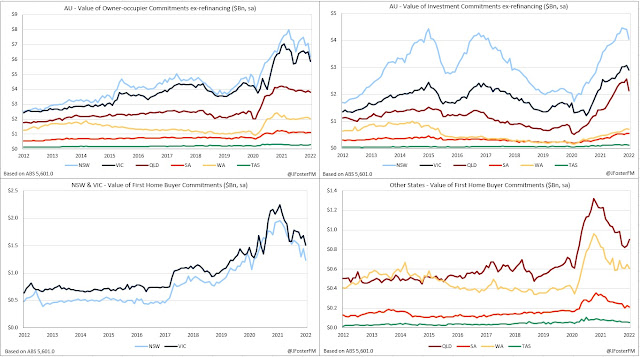Australian housing finance commitments posted their sharpest month-on-month fall since the outset of the pandemic, declining by 6.4% in April. This decline was likely accentuated by the high number of public holidays that fell during the month. Conditions in the housing market are cooling — CoreLogic reported prices nationally declined for the first time since September 2020 in May — though prices are still substantially higher over the Covid period, with reassessments being amid the RBA's rate hiking cycle.
Housing Finance — April | By the numbers
- Housing finance commitments ($ value, ex-refinancing) declined by 6.4% in April (vs -0.5% on the consensus) to $31bn. Commitments in March showed a revised gain of 2.1% from 1.6% initially reported. Annual growth to April slowed to 0.3% from 11.3%.
- Owner-occupier commitments were down by 7.3% on the month to $19.9bn (-12.8%yr).
- Investor commitments saw their first month-on-month fall since June last year, down 4.8% to $11.1bn (37.1%yr).
- Total refinancing fell by 2.6%m/m to $16.3bn (19.2%yr).
Housing Finance — April | The details
Housing finance commitments (home loans approved by lenders and then accepted by the borrower) fell in value by 6.4% in the month of April to around $31bn. This was the largest month-to-month decline in commitments since May 2020 as the pandemic struck. Some combination of the anticipation of a series of rate hikes from the RBA, the unusually high number of public holidays that fell in April and the cooling in market conditions in Sydney and Melbourne look to be behind today's outcome. The summary table (above) shows the declines in both the owner-occupier (-7.3%) and investor segments (-4.8%) were broad based across all sub-categories.
Owner-occupier approvals were down across the board, consistent with the effect of lower volumes going through due to the public holidays in April around Easter and then into ANZAC day. Approvals in the largest sub-category, the upgrader segment, declined by 5.8% in the month. Construction-related approvals were down by a similar magnitude (-5.9%).
The month-to-month changes across the states are summarised in the table below. Declines in the national aggregates were driven by New South Wales and Victoria, reflecting the slowdowns in their respective capital city markets, but likely also accentuated by lower volumes being processed.
Housing Finance — April | Insights
The house price cycle is starting to turn, with CoreLogic reporting the first decline in its national index since September 2020, prices down by a mere -0.1% in May. This is being driven by the Sydney (-1%m/m) and Melbourne markets (-0.7%m/m). With the RBA moving to hike rates in May and signalling more to come, housing prices, which lifted to high levels across the nation over the Covid period, are likely to lower. However, there are two tiers to this market: activity by owner-occupiers is slowing but the investor segment is up sharply over the year. Tight rental markets, discussed by Pete Wargent here, are a key factor in this.






